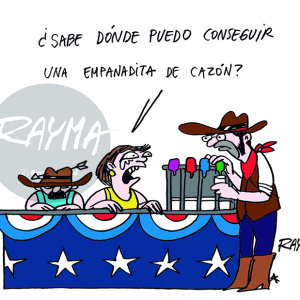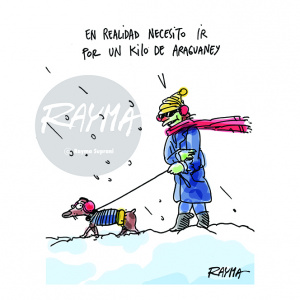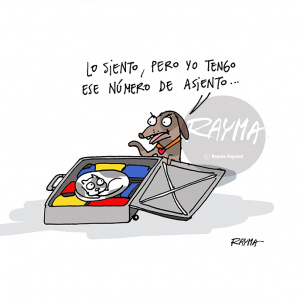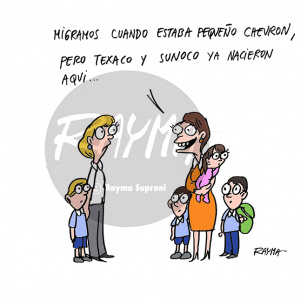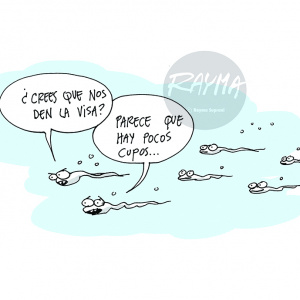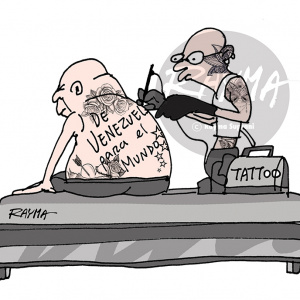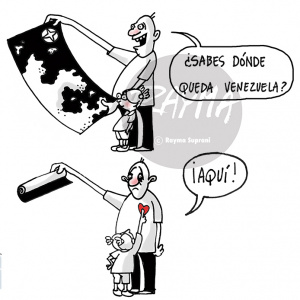“I am rooted, but I flow” Virginia Woolf
Dead and alive in the same shipwreck. Drawings by Rayma Suprani. The motivations that intertwine, in the current context of Venezuela, hundreds of men, women and children to be forced out in caravans, by more or less specific coordinates to any part of the world, converge in the desperate search for food, health and freedom. This is due to the shocking humanitarian crisis promoted by the tyranny in transit that after twenty years, today seems to be choking on its own remains. This and other hardships suffered by the immigrant is what provokes the critical will of the work of Rayma Suprani (Caracas, Venezuela 1969), in his exhibition I Immigrant: Houston. (BAG Art Gallery, Houston, Texas); His project, moved by the critical exodus of a people forced to flee in terror, acts as a territory of asylum that seeks, through the strategies of its scathing humor, to accompany those who managed to escape the terror.
While, paradoxically, they live trapped in the desire to return to the country, a return that must be protected under a framework of rights that allows everyone to live in freedom and far from tyranny. The conflict of a life crossed by passions usually represents a painful step through mental inflections, these can lead those who live them, to travel unsuspected routes or to be shipwrecked in an ocean of tribulations and trifles. The truth is that, no matter how diffuse its forms, it is clear that the breakdown of physical contact with people and things that influenced the emotional construction of each of us represents a tragic and difficult experience to bear.
In this sense, Rayma knows how to personify the drama of the exodus from his sensitivity and ingenuity. We all find a gesture of affinity and identity, an incentive and recognition, in his proverbial work. This page of the homeland history of Venezuela has become the opportunity for Rayma to interpret a particular aria through drawing, a confluence of voices and strokes, in which he narrates in the present tense, true facts loaded with a deep drama that, with optimism, shows signs of hope. Testimony that recalls the chronicles of the “Va pensiero” the chorus of the third act of the opera el Nabucco (1842) by Giuseppe Verdi (Le Roncole, Italy – 1901 Milan, Italy) where the composer also addresses the theme of exile. Verdi’s choir is assumed, at the time, by the Italian people with such passion that it becomes the battle song to recover their lost country, after having been segregated and occupied by foreign domination.
Verdi, even affected by that historical moment of his nation, escapes from the fear imposed to take the epic message to the hearts of his contemporaries. In this way, we can suggest that Rayma’s work is a commitment that contains the emotional and critical qualities necessary to summon resistance to the stormy surf. Exile is an immense, jumbled shipwreck. He is seldom appeased. Those who live it may be seen in the work of Rayma, a kind of frigate that will pick them up from the drift, his message goes straight to the heart, like the thought that forges freedom. Tragic and romantic image, which may well refer to The Raft of the Medusa, (circa 1818-1819) by Théodore Géricault, an immense canvas that represents the remains of a ship. At the bottom of the raft are lifeless bodies, also a couple of people who hold them under a hopeless gaze, while at the top are the survivors, waving their arms to try to be seen, as if they had been born in they the will of life and hope.
The cruelty and barbarism experienced by the crew during the voyage may not be so unreal with the limits of survival inside and outside the longed-for territory. The maneuvers and any other effort to revive life above the difficulties of bad weather and contrary winds, is the experience that offers the opportunity to wave any cloth in the hope of being rescued, but it is also an occasion to value the presence of other people who travel tight with us, waiting for us to extend our arms to avoid falling, after the aggressive movement of the waves, the gesture of solidarity. The objection expressed in Rayma’s drawings about the trip provides a clear message of virtue and encouragement. In turn, it refers us to the lucid words of Friedrich Nietzsche about the need to embrace life and abandon the inert. Living and dead in the same shipwreck is a message that travels straight to the heart, resuscitating us from the shadows of exile.
Pietro Daprano
Curator
-
Yo Immigrante Houston – Piece 1
$1,200.00 -
Yo Immigrante Houston – Piece 2
$1,200.00 -
Yo Immigrante Houston – Piece 3
$1,200.00 -
Yo Immigrante Houston – Piece 4
$1,200.00 -
Yo Immigrante Houston – Piece 5
$1,200.00 -
Yo Immigrante Houston – Piece 6
$1,200.00 -
Yo Immigrante Houston – Piece 7
$1,200.00 -
Yo Immigrante Houston – Piece 8
$1,200.00 -
Yo Immigrante Houston – Piece 9
$1,200.00 -
Yo Immigrante Houston – Piece 10
$1,200.00 -
Yo Immigrante Houston – Piece 11
$1,200.00 -
Yo Immigrante Houston – Piece 12
$1,200.00 -
Yo Immigrante Houston – Piece 13
$1,200.00 -
Yo Immigrante Houston – Piece 14
$1,200.00 -
Yo Immigrante Houston – Piece 15
$1,200.00 -
Yo Immigrante Houston – Piece 16
$1,200.00 -
Yo Immigrante Houston – Piece 17
$1,200.00 -
Yo Immigrante Houston – Piece 18
$1,200.00 -
Yo Immigrante Houston – Piece 19
$1,200.00 -
Yo Immigrante Houston – Piece 20
$1,200.00 -
Yo Immigrante Houston – Piece 21
$1,200.00 -
Yo Immigrante Houston – Piece 22
$1,200.00 -
Yo Immigrante Houston – Piece 23
$1,200.00 -
Yo Immigrante Houston – Piece 24
$1,200.00










